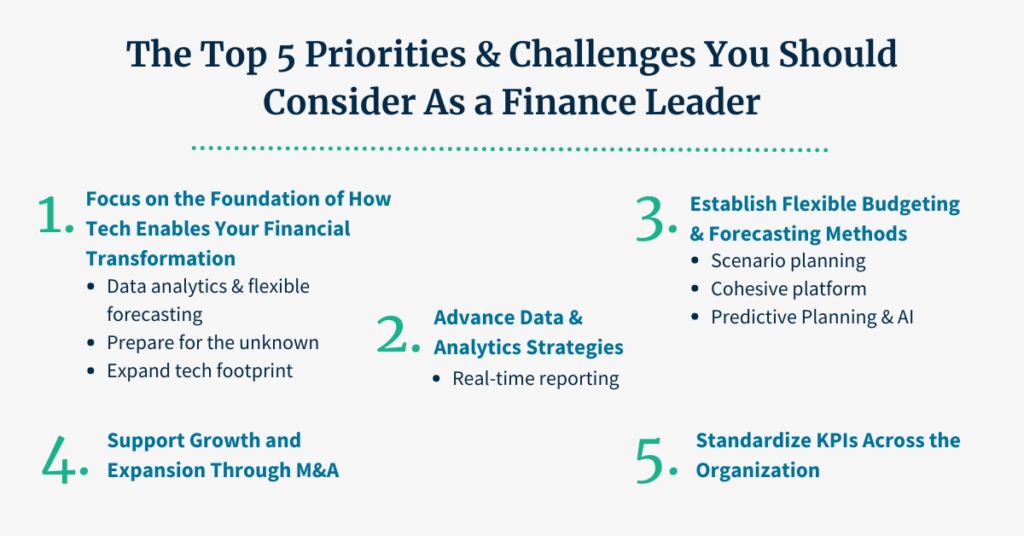As a Finance leader, a critical step in achieving long-term financial success is to develop a data strategy that allows your organization to adapt to change quickly while creating a cohesive platform that all levels of people in your organization can access and understand. Watch the following Strategic Whiteboard Series video, as Kelsey Finnegan explores the 5 main priorities and challenges Finance leaders need to capitalize on in order to drive future business decisions:
- Focus on the foundation of how technology enables your financial transformation
- Advance data and analytic strategies
- Establish flexible budgeting and forecasting methods
- Support growth and expansion through M&A
- Standardize KPIs across the organization
Click on the image above to open a high-resolution version in a new tab
Transcript
My name is Kelsey Finnegan, and I’m a Principal at SC&H Group. Today we’re doing another video in our whiteboard series. We’re going to be covering the top five priorities and challenges for finance leaders.
Enable Technology to Drive Business Decisions
Number one is enabling technology to drive business decisions and facilitate your financial transformations. So over the past few years, our clients have been starting to look more towards long-term strategies and trying to plan out for the next three to five years. What that entails is making sure that they have the vision for the reporting that they’re going to need to drive business decisions. The next few points that I’m going to talk about are some key components of that and how they can get there.
Advance Data and Analytic Strategies
Number two is enabling data and analytics strategies and starting to come up with how your company can use real-time reporting across all levels of the organization. This means making sure that you have a cohesive platform and standardized KPIs and reporting so that lower-level analysts all the way up to the executive tier are able to use this information and have data at their fingertips.
Establish Flexible Budgeting and Forecasting Methods
The next component is having a flexible forecasting and budgeting model. Over the past few years, especially as the economy has been changing, it’s been really important to be able to plan for the unknown and be able to do that quickly. Having a platform in place where you’re able to do what-if analysis and say, hundreds of my stores are closing across the company, what’s that going to do to my revenue and my business model? What if I need to cut costs by 10 percent, et cetera? Having that scenario planning and those types of capabilities in place is super important for people to be able to make quick decisions.
Support Growth and Expansion Through M&A
Number four is being able to plan for your mergers and acquisitions and have that M&A strategy. Most of my clients know when they’re going to buy a company and what that’s going to look like, but don’t necessarily have a plan. Once they do buy that company, how is that going to impact their reporting? How do they want to integrate that into their technology platform so that they’re able to again have that seamless platform that includes that holistic view of the organization? So making sure that you have a plan in place and a process to be able to integrate that into your technology is super important.
Standardize KPIs Across Your Organization
Number five is being able to standardize KPIs across your organization. A lot of our clients have multiple different business units, and whether that’s through mergers and acquisitions or just organic growth, a lot of our clients have disparate KPIs, and they may even be manual. It’s super important to make sure that everyone’s looking at the same thing, having the same numbers, accessing the same reporting, and being able to set that standard for your company so it can enable your business users to be able to make their own decisions to drive business growth.
In short, it’s super important to be able to enhance your technology platform, be able to see that long term strategy, and focus on those other four components to make sure that you’re at the end of the day, going to have that cohesive reporting platform that’s going to include flexible budgeting and forecasting a plan for any merger and acquisition data, as well as a data and analytics strategy that wraps everything together for your reporting needs so that you can drive business decisions. If your organization is looking for help in this area, please feel free to contact me. My information is below. Thanks for listening.






